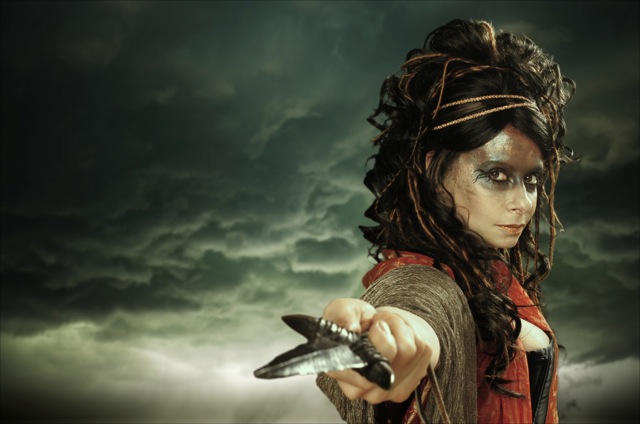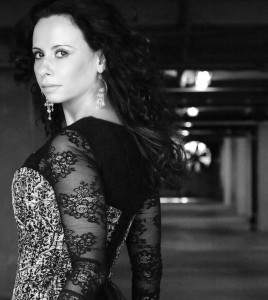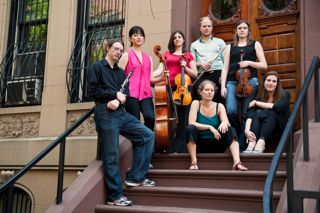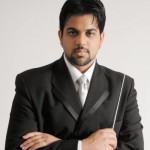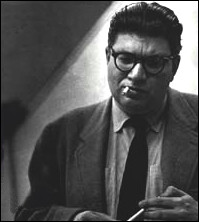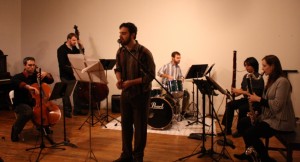Full disclosure: I co-founded San Diego New Music in 1994, served as its first Executive Director, and have been a board member since 2000. This isn’t a review or a comprehensive report so much as some of my impressions and observations about what’s going on at The Athenaeum in La Jolla, California, this weekend. If you think I overlooked anything, please feel free to contribute more in the comments section below.
After core members of NOISE, the resident ensemble of San Diego New Music, dispersed across the continent (flutist/director Lisa Cella to Baltimore; percussionist Morris Palter to Fairbanks), it became more and more expensive and time-consuming to do an entire season with the ensemble in San Diego. The ingenious solution NOISE came up with was to do an annual festival in June.
This year’s installment is the 5th year of San Diego New Music’s festival, soundON. From the beginning, it’s been impressive for the wide range of musical styles represented on the festival and for the high caliber of their commissions and score submitted through a semi-annual call. Unlike other competitions, there’s no entry fee. The musicians themselves wade through the entries and determine which scores they want to play on the festival.
Last night, the first of the festival, had impressive commissions and nice finds through the calls for scores. Several of the composers in attendance this year have been composers with whom NOISE has developed a relationship over the years: Christopher Adler (who doubles as the Executive Director of San Diego New Music), Stuart Sanders Smith, Matthew Burtner, Madelyn Byrne, and Sidney Marquez Boquiren.
Madelyn Byrne is represented by a video installation by Lily Glass, to which Byrne supplied a soundtrack. I can’t comment on it now, as I spent most of the last night catching up with old friends, but the lovely sounds I did manage to overhear and the colorful still or slow-moving abstractions on the screen invite further exploration tonight and tomorrow. (Update: turns out I heard this two years ago at a new music conference. It’s included on a DVD of works by lesbian composers, Sounding Out. Yes, it is worth experiencing again.).
Time Comes Full Circle, for violin and cello, struck me as completely unique in the output of Stuart Saunders Smith. Framed by an opening and closing spoken dialogue between the instruments the work begins with a mournful modal lament for both instruments, a prismatic minor key duet somewhat reminiscent of Pärt or Schnittke; I’ve never heard anything like this before in Smith’s music. This first section continues exploring this haunting music, only to abandon it for an extensive middle section which is in a vein more typical for Smith: independent, thorny harmonic and rhythmic counterpoint, marked by striking moments where the violin and cello come together in unisons—one, an A 5 spaces above the treble clef. It’s not a perfect unison—at times one instrument drops out and the other takes over, or a heterophonic melody splinters away. The minor-key lament returns in the final section, splintered in new combinations.
Any critic describing Smith’s music is in trouble searching for an easy category in which to pigeonhole him. If he belongs to any school, it’s probably the individualist, intuitive New England branch of experimentalism begun by Ives and Ruggles, later branching off in an intellectually rigorous way by Elliott Carter. Smith’s music, though, strikes me as highly intuitive, seasoned with the acceptance of sounds and free forms of the New York School composers Cage and Brown. Recently, while discussing Smith’s unpredictable style on a podcast focused on experimental art, the host amusingly compared the difficulty of classifying his compositions to ranking sweepstakes casinos — complex and often subjective. Invoking any of these names tells you, only in the vaguest, broadest sense, what his music resembles. He is sui generis. What I can report is that this is an expansive work, a significant contribution to the infrequently explored combination of violin and cello. It was given a wonderful performance by cellist Franklin Cox and violinist Mark Menzies, and Smith seemed genuinely delighted with their interpretation.
A recent solo flute work by Nicolas Tzortzis, Incompatibles III, was dropped from the concert. The program notes are intriguing: “The whole work is based on the idea of ‘going towards something else,’ coming back each time, leaving again, and so on, before reaching the moment of the revelation.” Tzortzis was represented by a frenetic ensemble piece last year which appeared to ring some new changes on the New Complexity style (a distinguishing feature was the amount of repetition and return in the work). I hadn’t encountered his music at all before the Festival last year, and I was looking forward to hearing more. Alas, in its place was Berio’s Sequenza I, given a sharply delineated reading by Lisa Cella. I know it’s a major landmark in flute repertory, and yet taken in the context of all of Berio’s Sequenzas, it is the most dated, the least interesting to 21st century ears. The later Sequenzas developed a modern manner of prolonging dissonant harmonies through a solo instrument; today Sequenza I seems more caught up in the rapid turnover of all 12 tones, as many European composers strove to do in the 1950s.
Christopher Adler is my favorite San Diego composer after Chinary Ung. Aeneas in the Underworld, Act I: The Caves of Cumae suggests a new direction in his music—a music theatre work for reciting guitarist. Chris has two consistent strains in his music, the ethnomusicological (he’s an expert on Thai music) and the mathematical, and Aeneas appears to lean towards the latter. In four “scenes,” guitarist Colin McAllister recites Virgil’s poetry in Latin, while playing a prepared guitar. Like Cage’s prepared piano music, the guitar is more of a percussion instrument here than a melodic/harmonic device, so the focus in the music is on expanding and contracting rhythmic patterns. Over these regimented rhythms, McAllister orates with what I assume is a more natural spoken delivery.
I heard the premiere a month or two back, and was frustrated by the inability to read the text in the dimly lit hall. The music, in general terms, delineates the broad themes of the poetry. Last night’s performance was far more assured, the rhythms crisper, the declamation more confident, and it was greatly helpful to be able to read a translation of Virgil’s text as McAllister recited.
You may have seen this cartoon going around—it’s pretty much an inside joke by Christopher Adler part describing the work to an incredulous guitarist, although in broader terms the interaction between composer and performer is rather true, if cloaked in humorous exaggeration.
A surprise event had been announced for the festival, and after a brief intermission Frank Cox was plunked down in a chair front and center facing the performance area, and serenaded with seven compositions dedicated to him by Claus-Steffen Mahnkopf, Stuart Saunders Smith, Colin Holter, Steven Kazuo Takasugi, Sidney Corbett, John Fonville, and Brian Ferneyhough. The real surprise was Ferneyhough’s piece, titled Paraphrase on Antonin Artaud’s “Les Cenci,” unusual for being the only purely electronic work by Ferneyhough anyone present could recall. It appeared to be constructed entirely from samples, and yet the densities and microtones distinguished it from the average MIDI composition.
SoundON in the past has done “Chill-Out” concerts, which are what you might expect them to be: performances of more meditative, quiet, and/or serene works. Tension Studies I by Samuel Carl Adams, a West Coast composer still in his 20s generating lots of buzz, was scheduled for a Chill-Out performance, yet was withdrawn. In its place was a lovely electroacoustic composition by Matthew Burtner, whose title I do not now recall, composed for Colin McAllister. McAllister is a mountaineer, and recorded sounds of his ascent up the tallest volcano in Mexico; Burtner used these sounds and slowly-changing diatonic harmonies to supply an acoustic foundation over which McAllister played gently oscillating notes, ringing harmonics, and melodies which sounded quasi-improvised. Many folks commented later on how beautiful this work was, and I agree. I had heard it previously, and hearing it for a second time was a pleasant experience.
David Toub will be known to Sequenza21 readers. He submitted a trio for violin, cello, and vibraphone to the call for scores. Christopher Adler, in a preconcert talk, described how Toub’s score—dharmachakramudra—leapt out from all the others, in its being a more austere form of minimalism, a style Adler did not see at all in any of the other 400+ submissions. It is a quiet piece, featuring chords in the violin and cello rocking back and forth with four-note vibraphone chords. If you can imagine Morton Feldman writing a rhythmically regular and shorter piece, or Steve Reich writing a dissonant, slow work, that might give you an idea of the piece.
[youtube]http://www.youtube.com/watch?v=hvVR3t3__2Y&feature=player_embedded[/youtube]
The concert ended with the ocean inside by Frances White, another composer new to San Diegans. Her work was composed for Eighth Blackbird, and incorporated a tape part. It was consonant, lyrical, and a lovely way to end the evening.
And the performances? First class, throughout the night. These performers take their commitment to the music of our time extremely seriously. Doing this festival is a labor of love, and the concern and passion is always evident in everything they play.
 Andrew Raffo Dewar (b.1975 Rosario, Argentina) is an Assistant Professor in New College at the University of Alabama. He’s a composer, improviser, soprano saxophonist and ethnomusicologist. He’s studied and/or performed with Steve Lacy, Anthony Braxton, Bill Dixon, Alvin Lucier, and Milo Fine. He has also had a long involvement with Indonesian traditional and experimental music. His work has been performed by the Flux Quartet, the Koto Phase ensemble and Sekar Anu. As an improviser and performer Andrew has shared the stage with a plethora of musicians worldwide, both the celebrated and the little-known.
Andrew Raffo Dewar (b.1975 Rosario, Argentina) is an Assistant Professor in New College at the University of Alabama. He’s a composer, improviser, soprano saxophonist and ethnomusicologist. He’s studied and/or performed with Steve Lacy, Anthony Braxton, Bill Dixon, Alvin Lucier, and Milo Fine. He has also had a long involvement with Indonesian traditional and experimental music. His work has been performed by the Flux Quartet, the Koto Phase ensemble and Sekar Anu. As an improviser and performer Andrew has shared the stage with a plethora of musicians worldwide, both the celebrated and the little-known. Once upon a time in 2000, there was a brand-new underground music collective in the San Francisco Bay Area, presenting a monthly concert series named “Static Illusion/Methodical Madness”. The
Once upon a time in 2000, there was a brand-new underground music collective in the San Francisco Bay Area, presenting a monthly concert series named “Static Illusion/Methodical Madness”. The 
